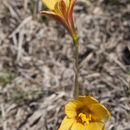en
names in breadcrumbs


Habranthus (copperlily)[1] was a formerly recognized genus of tender herbaceous flowering bulbs in the subfamily Amaryllidoideae of the family Amaryllidaceae.[2] It is now included within a more broadly circumscribed genus Zephyranthes. The genus was first identified by pioneering bulb enthusiast William Herbert in 1824.
Habranthus was formerly regarded separate from Zephyranthes; distinctive features included holding its flowers at an angle rather than upright, and possessing unequal stamens.[3] At one stage, Habranthus was considered a subgenus of the closely related Hippeastrum.[4] It was later treated as a full genus in the tribe Hippeastreae. However, molecular phylogenetic studies from 2000 onwards showed that although Hippeastreae was monophyletic, many of the genera placed in the tribe were not; in particular, Habranthus, Zephyranthes and Sprekelia formed a complex in which traditionally placed species were intermingled. Accordingly, in 2019, a broad circumscription of Zephyranthes was proposed, including the former genus Habranthus.[5] This proposal has been accepted by Plants of the World Online,[6] among other taxonomic databases.
In the United States, species formerly placed in Habranthus, like other rain lilies, are regarded as "heirloom plants", although not widely used in mainstream landscapes, perhaps because their bloom time, dependent on rain, is erratic. Nevertheless, the bulbs are rugged and easy to grow in USDA Hardiness Zones 8-10 and are recognized among bulb specialists as possessing distinct landscape value in appropriate areas of the world.[7] In colder regions they may be grown in sheltered sites, or in pots kept frost-free in winter.[3]
The most commonly grown species are the pink-flowered Zephyranthes robusta (formerly Habranthus robustus) and the yellow-flowered Zephyranthes tubispatha (formerly Habranthus tubispathus).[3]
Zephyranthes robusta (syn. H. robustus)
Zephyranthes tubispatha (syn. H. tubispathus), Denton, Texas
Habranthus (copperlily) was a formerly recognized genus of tender herbaceous flowering bulbs in the subfamily Amaryllidoideae of the family Amaryllidaceae. It is now included within a more broadly circumscribed genus Zephyranthes. The genus was first identified by pioneering bulb enthusiast William Herbert in 1824.